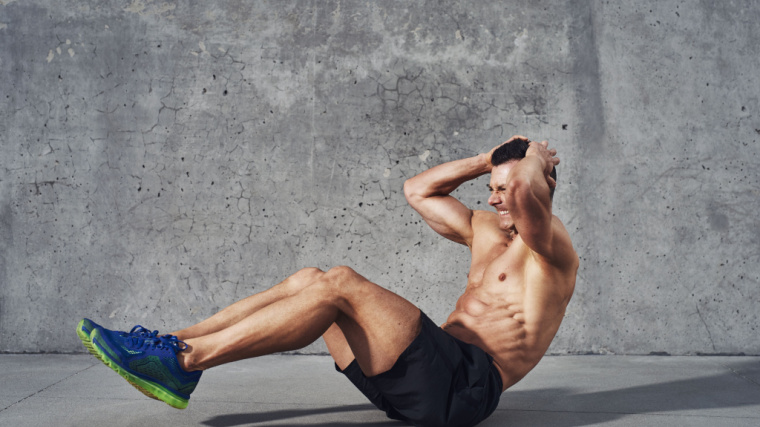Some people love them while others absolutely hate them. Crunches may be one of the most contentious ab exercises out there. The caution about crunches is understandable — if you only focus on this move, you’re paying attention to your “six-pack muscles” and risk neglecting to train your core from all angles.

It’s true that crunches alone don’t make a complete core workout regimen. But if you combine them with other core strengthening moves — exercises that incorporate rotation anti-rotation, and extension, for example — the oft-maligned crunch can be a valuable ally in your search for a strong set of abs. Here’s how to do the crunch properly, and why you should.
How to Do the Crunch
- Step 1 — Lie on your back. Bend your knees and plant your feet hip-width apart. Place your fingertips just above your ears with your elbows splayed wide, pulling them back toward the ground. Press your fingertips gently onto the sides of your head rather than gripping behind your neck or ears. Alternatively, cross your arms over your chest.
- Step 2 — Relax your shoulders. Tuck your chin very slightly toward your chest. On an inhale, draw your abs down and back without moving. Exhale and use your abs to guide your head, neck, and shoulder blades just off the ground. Make sure your movement is coming from your core rather than pulling upward from your arms or neck.
- Step 3 — Once your shoulder blades have left the ground, give your abs a final squeeze. Inhale and slowly lower back to the ground. To help increase your core engagement, ground your heels hard into the ground throughout each rep.
Why Do It: In addition to strengthening your flexion capabilities, crunches help you train yourself to feel your connection with your core and increase your mind-muscle connection while getting stronger. If you want to load it with weight, consider using similar form (but on your knees) for the cable crunch.
Equipment Needed: Yoga Mat or Exercise Mat
Crunch Variations
As helpful as crunches can be for creating stronger abs, they can admittedly get a little bit redundant. Try out these variations to kick some spice into your ab training.
Reverse Crunches
[Read More: The Best 10-Minute Ab Workouts to Strengthen Your Lifts and Your Six Pack]
- To do the reverse crunch, set up in a “regular” crunch position. Contract your core to bring your heels off the ground, keeping your legs at about a 90-degree angle.
- Activate through your core to crunch your knees up toward your chest. If you opt to increase the intensity, raise your shoulder blades off the ground as your knees approach your chest. Do not jerk up through your neck.
- Slowly and with control, return your heels until they’re just above the ground. Repeat for reps.
Bicycle Crunches
[Read More: The 10 Best Sit-Up Alternatives for a Stronger, More Powerful Core]
- For the bicycle crunch, set up as you would for a reverse crunch. Place your hands underneath your ears (to discourage tugging up at your neck and encourage you to press upward through your abdominals).
- On an exhale, peel your right shoulder off the ground, bringing your left knee and right elbow toward each other. Extend your right leg until it points straight out, roughly parallel to the ground.
- Come back to center slowly and with control. Repeat with the opposite limbs, and keep your reps even on both sides.
Bird Dog Crunch
[Read More: Are Your Abs Actually Strong, or Are Your Hip Flexors Doing the Work?]
- Get into a tabletop position with your hands under your shoulders and your knees underneath your hips.
- Press your left hand and right toes into the ground and prepare to keep your hips and shoulders squared and even. Engage your abdominal muscles.
- Slowly peel your right hand and left leg off the floor. Extend your right arm and left leg straight, reaching your toes toward the back of the room and your fingertips to the front of the room. Stabilize in this position.
- Bring your limbs back to starting position. Switch sides and repeat.
Crunch Alternatives
Don’t want to do the crunch at all? Or maybe it doesn’t agree with your lower back. Either way, you can try these non-crunch ab exercise alternatives.
V-Up
[Read More: 6 Core Exercises That Will Improve Your Squat and Deadlift]
- Start with your arms above your head — or by your sides if your shoulders are don’t allow for that— and your legs straight.
- Lift your limbs up until they form a V shape, with your hands and feet approaching each other above your torso.
- Aim to keep your lower back pressed into the ground to help make sure the movement is coming from your abs. Lower down with control and repeat.
Dead Bug
[Read More: Should You Train Core Every Day?]
- Lie on your back and assume an upside-down tabletop position, with your knees bent at 90 degrees above your hips, and your arms either bent or extended straight up above your shoulders.
- Engage your core and press your lower back down to the ground.
- Slowly extend your leg leg and right arm out so that they’re both parallel to the ground. Come back to center. Switch limbs and repeat.
Ab Rollout
[Read More: 3 Ab Exercises That Will Actually Help Your Lifts]
- Place an exercise mat under your knees. Grasp an ab wheel by the handles on the ground directly in front of you.
- Slowly and with control — avoid hyperextending your lower back — roll the wheel as far out in front of you as you can without collapsing or breaking form. Keep your shoulders stable throughout.
- When you reach your full range of motion, reverse the movement, rolling the wheel back to starting position. Repeat for reps.
Who Should Do the Crunch
Crunches may not be the only core exercise you want in your repertoire. But if core strength and muscle mass is your goal, it might just belong in your routine.
- Beginners: If you’re a newbie who’s dedicated to excellent form, the crunch might be a good core option for your beginner core workout. It can help you learn how to press your low back into the ground and activate your core without recruiting help from your hip flexors The crunch can also provide beginners with a base level of core strength.
- Strength Athletes: If you want to heft heavy weights, you need a strong core — that’s the bottom line. Crunches are one tool in your box to help you get there. How often should you train your abs in this journey toward strength? Two to three times a week is generally a good bet for experienced strength athletes, as long as it’s not interfering with recovery.
- Physique Athletes: Crunches may not be the most high-intensity ab-builder out there (unless they’re weighted), but they can provide a solid base of core strength upon which to build a powerful six-pack. Consider tossing them into your next bodybuilding ab workout.
Crunch Sets and Reps
- For Core Activation: To increase your mind-muscle connection with your abs, perform two to three sets of 12 to 15 very slow, deliberate reps.
- For Muscle: Do three to five sets of 15 to 20 reps. If needed, progress the crunch by holding a weight plate at your chest — as long as your form remains perfect.
- For Endurance: Once you’re able to perform at least 20 reps per set with perfect form, aim for four to five sets of 25 to 35 clean reps each.
Benefits of the Crunch
The crunch may not be the only core exercise you want in your routine, but there are still plenty of reasons to include it.
Target the Rectus Abdominis
Even if you don’t have an aesthetics-related goal, strengthening all parts of your abs is an important part of being able to hold a solid core brace during heavy lifting. Integrating crunches into a holistic approach to core training can help you develop the strong core you need to support those big lifts.
No Equipment Required
This one’s fairly self-explanatory. While the dumbbell ab workout is excellent, you don’t need any equipment to build stronger abs. That makes crunches a particularly useful addition to travel workouts and even early morning workouts when you’re just trying to get your day started.
Teaches Mind-Muscle Connection
If you’re going to do crunches correctly, you need to focus on contracting your abs. This focus will help you practice developing a stronger mind-muscle connection. The stronger your ability to consciously activate your abs, the better you’ll be able to do this under the intense loads of a barbell.
Increase Core Endurance
Specifically training your abs with moves like crunches can help boost your core’s ability to support high workloads with barbell and dumbbell work. That way, your core will be less likely to become the limiting factor of those lifts.
Muscles Worked by the Crunch
Ask a hater, and they’ll tell you that in addition to potential form errors, the crunch only works one part of your core. That’s true — it really only focuses on the rectus abdominis. But that’s not necessarily a reason to cast out the exercise.

The rectus abdominis is the most easily visible part of your abs — it’s what you’re thinking about when (and if) you dream about six-pack abs. The crunch primarily — and pretty exclusively — targets this core muscle.
- Rectus Abdominis
Common Crunch Mistakes
Much of the intense criticism of crunches comes from lifters’ tendency to perform them incorrectly. But if you perform them with proper crunch form, they can be an effective addition to a well-rounded core routine.
Though they look simple, make sure you know how to do crunches properly before proceeding.
Crunching With Your Shoulders
The cousin of straining your neck is crunching your shoulders instead of your abs. Your shoulders should stay relaxed throughout your reps. Instead of letting your shoulders curl forward, keep them in the same position the whole time.
Only your abs should be curling forward. Your shoulders, neck, and head are just along for the ride. Consider how steady you keep your upper body for lower ab exercises, and aim to rely on your core just as much here even though your shoulders are moving.
Sitting Up Too Far
Crunches and sit-ups may have similar set-ups, but they’re not the same beast. When you’re aiming to do crunches, you’re intentionally keeping your range of motion small. Don’t give into the temptation to turn crunches into a whole different exercise.
Crunches allow you to give your abs that extra squeeze at the top of their tension — the moment your shoulder blades leave the ground — and then reset for the next rep. Press your lower back into the ground to help keep you connected to your core throughout the move.
Straining Your Neck
When you set up to perform crunches, slightly tuck your chin toward your chest. Maintain that position consistently, being careful not to bring your chin further down to your chest throughout the move. With upper ab exercises (and all core moves), you want the movement to come from your abdominals, not your limbs or neck.

If you tend to yank your torso up and lead with your arms when your hands are by your ears, cross them over your chest instead. Imagine your abs leading your chest and shoulders, which in turn lead your chin and neck, instead of the other way around.
It’s Crunch Time
When you’re crafting a core routine, you’ll want to select the exercises that best match your goals. Crunches may not train your core from all angles, but they’re excellent for building muscle and strengthening your rectus abdominis — which is a crucial part of your abs.
Especially if you’re seeking to build that six-pack or develop a stronger mind-muscle connection with your abs, crunches can get you there. Just make sure you’re crunching your abs, not your neck, and you’ll do a great job.
FAQs
If you’ve got more questions about crunches, you’re in the right place — here are your answers.
No one exercise on its own will give you a six-pack. Like everything in fitness, it’s a balance of a whole lot of factors — think nutrition and your overall training regimen. But crunches can strengthen and grow the muscles of your rectus abdominis, which are the most visible muscles in a “six pack.” So crunches can definitely be a solid part of your six-pack plan.
Your set and rep scheme will depend on your goals. If you’re looking to build endurance, crunches are a decent exercise to perform upwards of 25 reps per set. But if you’re focused more on muscle mass, weighted crunches — or even just bodyweight crunches — divided into sets of 15 to 20 reps can be helpful.
If you’re an advanced lifter and are using good form, you could do crunches daily. But if you’re advanced enough such that you could do crunches every day without impacting your recovery, there’s probably no point in doing them. Try interspersing them into your program two or three days a week. When it feels like they’re no longer challenging, it’s probably time to level up your core training.
Featured Image: Prostock-studio / Shutterstock